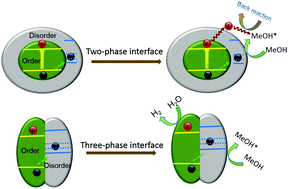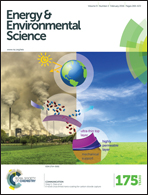An order/disorder/water junction system for highly efficient co-catalyst-free photocatalytic hydrogen generation†
Abstract
Surface engineering of TiO2 is faced with the challenge of high solar-to-hydrogen conversion efficiency. Recently, surface-disordered TiO2, referred to as black TiO2, which can absorb both visible and near-infrared solar light, has triggered an explosion of interest in many important applications. Unfortunately, the mechanism underlying the improved photocatalytic effect from an amorphous surface layer remains unclear and seems to contradict conventional wisdom. Here, we demonstrate selectively “disorder engineered” Degussa P-25 TiO2 nanoparticles using simple room-temperature solution processing, which maintain the unique three-phase interfaces composed of ordered white-anatase and disordered black-rutile with open structures for easy electrolyte access. The strong reducing agent in a superbase, which consists of lithium in ethylenediamine (Li-EDA), can disorder only the white-rutile phase of P-25, leaving behind blue coloured TiO2 nanoparticles. The order/disorder/water junction created by the blue P-25 can not only efficiently internally separate electrons/holes through type-II bandgap alignment but can also induce a strong hydrogen (H2) evolution surface reaction in the sacrificial agent containing electrolyte. As a result, the blue P-25 exhibited outstanding H2 production rates of 13.89 mmol h−1 g−1 using 0.5 wt% Pt (co-catalyst) and 3.46 mmol h−1 g−1 without using any co-catalyst.


 Please wait while we load your content...
Please wait while we load your content...